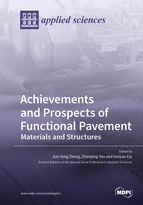Achievements and Prospects of Functional Pavement: Materials and Structures
A special issue of Applied Sciences (ISSN 2076-3417). This special issue belongs to the section "Materials Science and Engineering".
Deadline for manuscript submissions: closed (31 December 2018) | Viewed by 81742
Special Issue Editors
Interests: asphalt mixture mechanical property; asphalt pavement design; special soil subgrade; road maintenance
Special Issues, Collections and Topics in MDPI journals
Interests: design, construction, and maintenance of pavements; micromechanics for road materials; discrete and finite element modeling techniques; construction materials: asphalt, aggregate; alternative and recycled materials for civil engineering
Special Issues, Collections and Topics in MDPI journals
Interests: mechanics of multiphase media; experimental testing and constitutive modelling of pavement materials; pavement analysis & design; multi-physics flow and damage phenomena in asphalt mixtures; non-linear finite element analysis techniques; experimental testing and constitutive modelling of structural interlayer systems; experimental testing and computational characterization of multilayer asphalt surfacing systems on orthotropic steel deck bridges; multi-scale constitutive modelling of asphalt concrete; induction healing technology for asphalt concrete; warm rubberized asphalt concrete technology; waterproofing membrane material development and testing method; epoxy modified bitumen technology for durable and sustainable pavement; cold in place asphalt concrete recycling; high quality recycling of polymer modified asphalt; warm/cold rubberized asphalt concrete technology
Special Issues, Collections and Topics in MDPI journals
Special Issue Information
Dear Colleagues,
In order to further promote the development of functional pavement technology, summarize the research results of functional pavement, and determine future development directions, this SCI-indexed journal has launched a Special Issue of carefully selected and invited articles, on the topic of “Achievements and Prospects of Functional Pavement: Materials and Structures”. The following topics are considered to be included in the scope of this journal:
The theme of this conference is "The Achievements and Prospects of Functional Pavement", which is divided into the following topics:
1. Green roads
1) Pavement design and construction technology based on carbon emission
2) Pavement material can be replaced with application technology
3) Low noise, low pollution and other low impact road application technology
2. Safety pavement
1) Design and construction technology of durable drainage pavement
2) New materials and new technologies for road snow removal
3) Evaluation and optimization of anti-skid performance of pavement
3. Intelligent roads
1) Pavement state intelligent monitoring technology
2) Power generation, temperature control, and other functional roads
3) Pavement intelligent management application technology
4. Durable roads
1) New theory and new method of durability pavement structure design
2) Study on decay regularity and prediction model of pavement performance
3) A new design method for high performance asphalt mixture
All the papers will be peered reviewed. This journal is an open access journal and therefore a fee setup by the publisher will be charged which is not related to the guest editors.
Prof. Dr. Jian-long Zheng
Prof. Dr. Zhanping You
Dr. Xueyan Liu
Guest Editors
Manuscript Submission Information
Manuscripts should be submitted online at www.mdpi.com by registering and logging in to this website. Once you are registered, click here to go to the submission form. Manuscripts can be submitted until the deadline. All submissions that pass pre-check are peer-reviewed. Accepted papers will be published continuously in the journal (as soon as accepted) and will be listed together on the special issue website. Research articles, review articles as well as short communications are invited. For planned papers, a title and short abstract (about 100 words) can be sent to the Editorial Office for announcement on this website.
Submitted manuscripts should not have been published previously, nor be under consideration for publication elsewhere (except conference proceedings papers). All manuscripts are thoroughly refereed through a single-blind peer-review process. A guide for authors and other relevant information for submission of manuscripts is available on the Instructions for Authors page. Applied Sciences is an international peer-reviewed open access semimonthly journal published by MDPI.
Please visit the Instructions for Authors page before submitting a manuscript. The Article Processing Charge (APC) for publication in this open access journal is 2400 CHF (Swiss Francs). Submitted papers should be well formatted and use good English. Authors may use MDPI's English editing service prior to publication or during author revisions.
Keywords
- Functional Pavement
- Green road;
- Safety pavement
- Intelligent road
- Durable road
- Pavement materials
- Asphalt pavements








